"Champignon de Paris"
April 23, 2009
- Vol 1, Issue 5
| |
|
Updated
Website
|
If you haven't visited our website lately, take a
look. We are updating and expanding our site
daily. I think you will enjoy the changes.
|
E-Newsletter
Drawing
|
If you receive our newsletter, you will be
entered into a drawing each month for a great prize for
your kitchen. Check here each month to see if you
have won, if so, come in to collect your
prize!
March's
winner:
Brenda
Venturacci
Brenda
won a Recipe Card set --
Congrats
Brenda!
__________________ | |
|
Appreciating
Mushrooms
|
The
proliferation and acceptance of cultivated mushrooms
started as a rather serendipitous happenstance. Around
the turn of the twentieth century, an enterprising
florist in Kennett Square, PA, 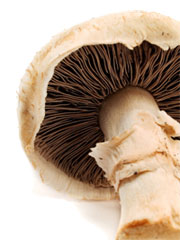 sought to optimize his greenhouse
space and began cultivating mushrooms underneath his
plant benches. Dark and damp, the conditions
proved perfect for mushroom growing. His floral market,
New York and Philadelphia, were also perfect targets for
this secondary crop. Another surge in mushroom
popularity around the mid '70's turned this specialty
crop into commodity produce. A crop now worth nearly one
billion dollars a year, mushrooms have spread into our
kitchens and have been eagerly welcomed. In this issue
we'll provide a glossary of commonly available
mushrooms, discuss "umami," the fifth taste sensation,
and offer instruction on two essential cooking
techniques, roasting and sautéing. We finish with
three recipes featuring mushrooms that will have your
mouth-watering in
anticipation. sought to optimize his greenhouse
space and began cultivating mushrooms underneath his
plant benches. Dark and damp, the conditions
proved perfect for mushroom growing. His floral market,
New York and Philadelphia, were also perfect targets for
this secondary crop. Another surge in mushroom
popularity around the mid '70's turned this specialty
crop into commodity produce. A crop now worth nearly one
billion dollars a year, mushrooms have spread into our
kitchens and have been eagerly welcomed. In this issue
we'll provide a glossary of commonly available
mushrooms, discuss "umami," the fifth taste sensation,
and offer instruction on two essential cooking
techniques, roasting and sautéing. We finish with
three recipes featuring mushrooms that will have your
mouth-watering in
anticipation.
|
| April Wine of the
Month |
 This month we're
featuring: Colores del
Sol
2008 Argentinean Malbec
Regular
Price: $12.00
April
Price: $10.00 Click to learn
about this slick new wine aerator now in stock:
|
| April Beer of the Month |
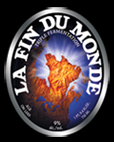 Because our Beer Tasting in March
went over so well, we've decided to make it permanent.
We will now have a monthly beer tasting and a Beer of
the Month! Because our Beer Tasting in March
went over so well, we've decided to make it permanent.
We will now have a monthly beer tasting and a Beer of
the Month!
Unibroue's
La Fin du Monde
$2.50/bottle |
Upcoming
Events!
|
Jill's Quick Kitchen
Organization Tip:An organized
kitchen saves time and money. Cooking and clean-up
time is more efficient and duplicate purchases are
reduced!
Come learn
more! Saturday, April
25th!
 | | |
|
More Upcoming
Events!
|
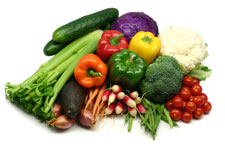 Saturday, May 2nd - Vegetable Gardens in
the Great Basin - Join Jill Phillips, local
Master Gardener, as she will be giving free tips and advice
for planting a vegetable garden in the Great
Basin. Saturday, May 2nd - Vegetable Gardens in
the Great Basin - Join Jill Phillips, local
Master Gardener, as she will be giving free tips and advice
for planting a vegetable garden in the Great
Basin.
6th Annual
Mother's Day Tea Basket Drawing - Enter your mother to
win our fabulous basket of tea goodies. Winner will be
announced in the next issue of this newsletter (May
7th). |
Save 25% 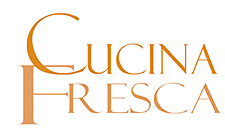
|
MOTHER'S DAY
SPECIALS
Whether your Mom is a fan of coffee,
tea, wine, margaritas, martinis, champagne, or beer . . . . we
have her covered with a great selection of specialty, themed
drink ware:
- All Mugs - 25%
OFF
- Themed Bar Glassware -
25%
OFF
- Buy an Aerogarden,and
receive 25%
OFF any Seed Kit
One coupon per person/per purchase
during from now through May 9th. Cannot be used in combination
with any other promotion, sale or coupon.
|
|
Offer valid now through May
9, 2009.
|
A Forest of
Mushrooms
|
Mushrooms
are in a special plant class of their own, fungi. Most
fungi grow on dead and decaying matter independent of
sunlight. Ironically, mushrooms are one of the few rich
sources of naturally-occuring Vitamin D, the "sunshine"
vitamin. No longer dependent on the forest floor for favorable
co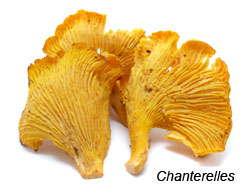 nditions, mushrooms are grown in dark,
cool, damp buildings known as mushroom farms. Mushrooms
do not have seeds, but have spores for creating the next
generation. Spores are scattered on specific mixes of
sawdust, corn cobs, and other decaying matter. Runners,
known as mycelium, begin to form in the soil. Mushrooms sprout
as the "fruit" producing more spores on dark, papery gills
located on the cap's underside. It takes four to six weeks for
a crop to grow from spore to harvest. nditions, mushrooms are grown in dark,
cool, damp buildings known as mushroom farms. Mushrooms
do not have seeds, but have spores for creating the next
generation. Spores are scattered on specific mixes of
sawdust, corn cobs, and other decaying matter. Runners,
known as mycelium, begin to form in the soil. Mushrooms sprout
as the "fruit" producing more spores on dark, papery gills
located on the cap's underside. It takes four to six weeks for
a crop to grow from spore to harvest.
Once the purview
of secretive mushroom hunters, mushrooms are standard issue in
today's grocery markets. Until recently, fresh mushrooms
meant white button mushrooms -- and they still comprise 85% of
the cultivated market. However, in the last several years, the
fresh options have expanded greatly. Below is a brief
glossary of commonly available mushrooms to help guide you:
(Courtesy of the Mushroom Council).
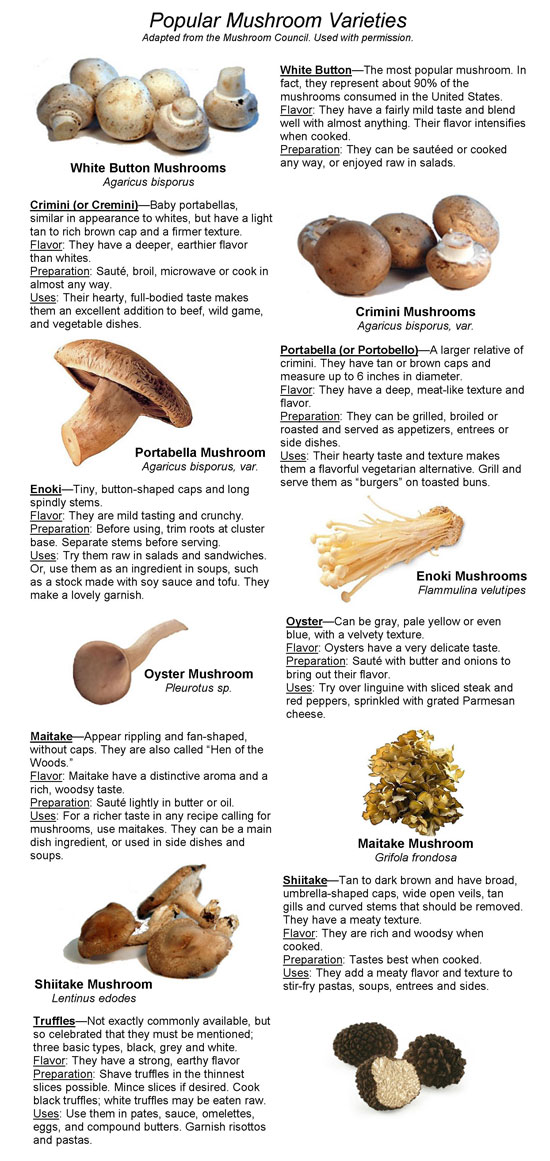 |
The Fifth Taste -
Umami
|
Pronounced "oo-MAH-may," umami is
the "fifth taste." Most of us grew up schooled on the
four types of taste sensations: sweet, sour, salty and bitter.
Anecdotally, the famous French chef, Auguste Escoffier, and
the Japanese scientist, Kikunae Ikeda, both hit on umami as
the fifth taste, something separate and distinct from the
other four tastes. The fifth taste is often described as
"brothy," "meaty," or, as the word umami translates, "yummy."
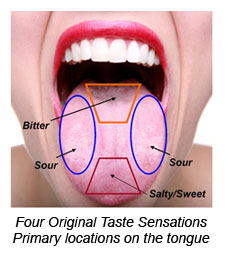 Scientifically, the sense of taste is
supported by thousands of taste buds. These specialized
receptors are positioned throughout the mouth, particularly on
the little bumps, papillae, of the tongue. They are also
located on the sides and roofs of our mouths. Different
individuals have different quantities of taste buds; an
"average taster has about 184 taste buds per centimeter of
tongue, a "supertaster" has 425, and "non-tasters" only
96. Scientifically, the sense of taste is
supported by thousands of taste buds. These specialized
receptors are positioned throughout the mouth, particularly on
the little bumps, papillae, of the tongue. They are also
located on the sides and roofs of our mouths. Different
individuals have different quantities of taste buds; an
"average taster has about 184 taste buds per centimeter of
tongue, a "supertaster" has 425, and "non-tasters" only
96.
The specialized receptors respond to one of the
taste types. What was informally known about umami was
confirmed scientifically in 2002 when neuroscientists
discovered specific receptors for L-glutamate
on the tongue. It is this L-glutamate that comprises the
primary umami sensation. L-glutamate is a consequence of
glutamate, a component of nearly all organic matter, breaking
down as it ages, ferments, or cooks. Glutamate is a common
amino acid found in both plant and meat protein structures.
Umami is also evoked by other micro-elements
known as nucleotides, specifically, inosinate
and guanylate.
Inosinate is generously found in meat and seafood, while
guanylate is found in mushrooms. The combination and
proportion of these chemical elements creates different umami
sensations. Chefs seek to amplify the "yummy factor" through
the synergistic use of foods rich in the molecular components
of umami. By combining onions, (rich in glutamate) and
mushrooms, (rich in guanylate), with a beefy stock, (rich in
inosinate), the umami receptors become quite
satiated!
Foods containing large quantities of umami
elements include fish, shellfish, beef, pork, and
chicken. In the plant world, mushrooms are rich in umami
tastes, as well as tomatoes, seaweed, soy beans, potatoes,
Chinese cabbage, and carrots. In the dairy world, Parmesan
cheese heads the umami
list.
|
Roasting
and Sautéing Vegetables
|
Once was
the day that cooking vegetables meant boiling them until mushy
and drab in color. No wonder vegetables disappeared from
our dining table! Then, we discovered steaming! Steaming kept
vegetables appealing in color and inviting with their
crisp-tender texture. Steaming remains a perfectly
healthy and appropriate cooking method. However, as of
late, it's roasting and sautéing vegetables that's taken a
prominent role in the kitchen.
Roasting
Vegetables - Roasting is a cooking technique invoking
high, dry heat to the food at hand. This process evaporates
the water in the food leaving the essence of the food in a
concentrated form. It's this concentration of flavors and
slight caramelization of the vegtables' sugars that makes them
particularly flavorful.
How to Roast
Vegetables:
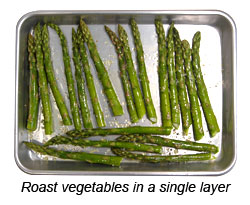
- Prep your vegetables by peeling, snapping, or trimming.
- Wash the vegetables well, then pat dry. We like to
allow the vegetables to air dry for a few minutes to ensure
that excess water is minimized.
- Spread the vegetables in a single layer on a baking
sheet without crowding. A baking rack may be used if
desired.
- Drizzle a bit of olive oil over the vegetables, and toss
gently.
- Sprinkle sea salt, and add freshly ground pepper.
- Bake in a 400-425° F oven until the vegetables are just
tender.
The key to roasting vegetables is a single
layer arrangement. If you have more than a single layer of
vegetables, roast in two batches. It's important that
the high heat reach the vegetables -- overcrowding will simply
steam them instead of roasting them.
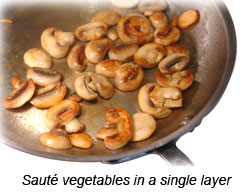 Sautéing
Vegetables - Sautéing is another high heat method of
cooking that also serves to evaporate the vegetables' water
while concentrating the flavors. As with roasting, the
high heat inspires the Maillard reaction, more commonly known
as caramelization. The butter or olive oil deployed in
the process also adds to the delectable flavor layers. Similar
to roasting, one key to a good sauté is not overcrowding the
pan. Add only a single layer of vegetables at a time.
Sauté in two batches if necessary. Sautéing
Vegetables - Sautéing is another high heat method of
cooking that also serves to evaporate the vegetables' water
while concentrating the flavors. As with roasting, the
high heat inspires the Maillard reaction, more commonly known
as caramelization. The butter or olive oil deployed in
the process also adds to the delectable flavor layers. Similar
to roasting, one key to a good sauté is not overcrowding the
pan. Add only a single layer of vegetables at a time.
Sauté in two batches if necessary.
How to Sauté
Vegetables:
- Prep your vegetables by peeling, snapping, or trimming.
- Wash the vegetables well, then pat dry. We like to
allow the vegetables to air dry for a few minutes to ensure
that excess water is minimized.
- Heat a sauté pan over a medium-high burner or flame.
- Add a small amount of olive oil to the heated pan and
allow the oil to heat
- Add the prepared vegetables; stir or toss to coat with
the hot oil.
- Stir or toss gently during cooking until the vegetables
are cooked to tenderness.
- Sprinkle sea salt, add freshly ground pepper, and
serve.
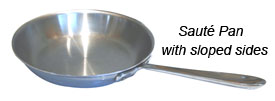 Use a high-quality sauté pan that has a
broad, flat bottom and sloping sides. A sauté pan
facilitates the tossing of its contents instead of
stirring. Stirring may damage tender portions of the
vegetables. To toss, push the pan forward abruptly so
that its contents slide up the sides of the pan. Catch
the airborne veggies in the center of the pan. The short
flight time allows the vegetables to land in a different
position and evenly cook on all sides. With a little
practice, your sauté tossing skills will be a source of
admiration! Use a high-quality sauté pan that has a
broad, flat bottom and sloping sides. A sauté pan
facilitates the tossing of its contents instead of
stirring. Stirring may damage tender portions of the
vegetables. To toss, push the pan forward abruptly so
that its contents slide up the sides of the pan. Catch
the airborne veggies in the center of the pan. The short
flight time allows the vegetables to land in a different
position and evenly cook on all sides. With a little
practice, your sauté tossing skills will be a source of
admiration!
|
Cucina Fresca's Smart Mushroom
Tips
|
Tip #1: Use a
mushroom brush to clean your mushrooms. A mushroom brush
has softer bristles than typical vegetable brushes. The soft
bristles will whisk away any dirt particles without damaging
or tearing the delicate flesh of the mushroom.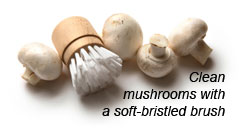
Tip #2: When buying
mushrooms, choose those that look freshest and without any
bruising or evidence of excess moisture. Bruised
mushrooms deteriorate quickly. Excess moisture will also
precipitate a quick demise. A cap that is closed indicates a
younger mushroom with delicate flavor; an open cap is still
quite fresh and will actually have a richer
flavor.
Tip
#3: Mushrooms may be stored in the refrigerator
for up to a week in their original packaging. Once the
package is opened, store the mushrooms in a paper bag. Avoid
storing mushrooms in a plastic bag or container. Allow them to
breathe a bit and keep them away from any condensation
opportunities.
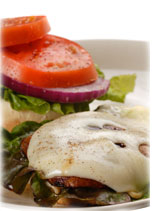 Tip #4: When sautéing
or roasting, olive oil, (or other oils with higher smoke
points), matches the situation well. If you like the
flavor of butter, use a combination of olive oil and butter;
this will raise the overall smoke point while decreasing the
overall saturated fat content. Tip #4: When sautéing
or roasting, olive oil, (or other oils with higher smoke
points), matches the situation well. If you like the
flavor of butter, use a combination of olive oil and butter;
this will raise the overall smoke point while decreasing the
overall saturated fat content.
Tip #5: Use a large
Portabella mushroom as you would a hamburger. Brush the
large cap with olive oil, grill for about 4-6 minutes on each
side. Load it up with sliced red onions, roasted red
peppers, your favorite cheese, even ketchup or mustard if you
like!
Tip
#6: When preparing mushrooms for stuffing, use a
melon baller to "scoop out" the gills and any excess flesh.
Save the trimmings and stem pieces; chop and add them to the
stuffing for added
flavor.
|
Cookbook
Review
|
Fresh
Every Day, More Great Recipes from Foster's Market by
Sara Foster with Carolynn Carreño. Copyright 2005. Clarkson
Potter/Publishers, an imprint of Crown Publishing Group, a
division of Random House, Inc., New York, NY.
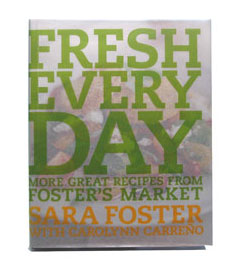
The change in season brings a
welcome change in harvests. Access to fresh ingredients
increases in a variety of ways - from our gardens, reopened
farmer's markets, and seasonal choices at supermarkets. This
cookbook celebrates "freshness." More than a buzzword,
or part of the "Buy Fresh, Buy Local" slogan, "fresh" looks
good and tastes great! Building on a style of cooking
that begins with what's available today, Foster puts practical
reality with a refreshed view of what "home cooking" can be in
the enlightened age of nutritional awareness and sustainable
food sources. The eight chapters range in breadth: "Breakfast
for Anytime," "Simple Soups," "Seasonal Salads and Salad
Meals," "Seasonal Sides," "Quick and Tasty Meat Main Dishes,"
"Fast and Fresh Fish, Pasta, and Risotto Meals," "Meals that
Cook Themselves," and "A Little Something Sweet." Ms.
Foster encourages us to use her recipes as jumping off points
and provides us ample confidence to do so through clear
instructions, notes that riff on her themes, and generous
suggestions.
|
Recipes with
Mushrooms
|
Recipes excerpted from Fresh
Every Day, More Great Recipes from Foster's Market by Sara Foster with Carolynn
Carreño. Copyright 2005. Clarkson Potter/Publishers, an
imprint of Crown Publishing Group, a division of Random House,
Inc., New York, NY. Used with permission. All rights
reserved.
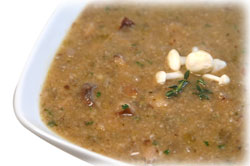 Wild Mushroom Soup with Sherry and
Thyme Wild Mushroom Soup with Sherry and
Thyme
At home in spring as well as fall, this
soup is delicate and satisfying all at once. We used a variety
of mushrooms for maximum flavor. Absent from this recipe is
any cream or heaviness. Instead, a portion of the soup is
pureed and returned to the pot for natural thickness. The
soup's rich flavor is predominantly earthy mushroom enhanced
with sherry and an herbal touch of thyme.
Click here to view the
recipe.
Click here for a
printable
version of the recipe.
Jonathan's
Grilled Eggplant and Portobello 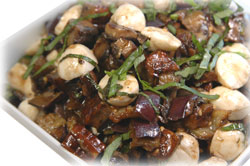
Mushroom
Salad with Fresh Mozzarella
We predict that this
salad will be the season's new standard. Grilling the eggplant
and Portobello mushrooms lent a smoky complexity to the
overall flavor. The simplest of vinaigrettes was
simultaneously a suitable marinade and dressing. We used
cherry-sized balls, Ciliegine, of fresh
mozzarella to coordinate with the bite-sized vegetables.
This was a great do-ahead dish that only got better as it
rested.
Click here to view the
recipe.
Click here for a
printable
version of the recipe.
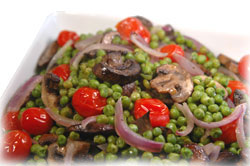 Roasted Mushrooms with Green Peas and
Tomatoes Roasted Mushrooms with Green Peas and
Tomatoes
This recipe makes quick use of your
newly honed roasting skills. Colorful and flavorful, the
roasted mushrooms, peas and grape tomatoes yield the desired
concentrated flavors. Mastered in the first making, the
methods in this recipe are a perfect place to begin applying
improvisational roasting skills that will prove useful
throughout the spring and summer ahead.
.
Click here to view the
recipe.
Click here for a
printable
version of the
recipe.
|
Bridal
Registry
|
Wedding
season in quickly approaching. Join us in celebrating the
engagements and pending nuptials for the following couples
registered at Cucina Fresca in 2009:
Ruth
Meyer and Tim Feldman
Wedding Date:
June 27th 2009
Victoria Nalywaiks and
Nicholas Richardson
Shower Date: June
5th, 2009
Wedding Date: July 4th, 2009
Korrie Vance
and Shaun Hornbarger
Wedding Date: July
18th 2009
Holly
Gilbertson and Brett Hoffman
Wedding
Date: August 15th 2009
Wedding Registry
List is available on our
website! | |
Wishing
you the best as you develop your mycologically-inspired
culinary explorations!
|
|
| |